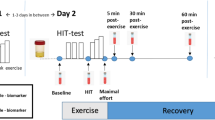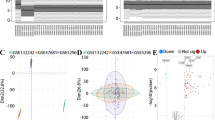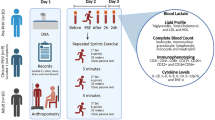Abstract
Study design:
Nonrandomized study.
Objectives:
The purpose of this study was to determine the effects of long and intensive exercise on interleukin-6 (IL-6) and tumor necrosis factor-α (TNF-α) in athletes with cervical spinal cord injuries (CSCI).
Setting:
The 30th Oita International Wheelchair Marathon Race.
Methods:
Blood samples from six athletes with CSCI and eight athletes with thoracic and lumber spinal cord injuries (SCI) participating in wheelchair half marathon race were collected before the race, immediately after the race and 2 h after the race. IL-6, TNF-α, adrenaline and blood cell counts were measured.
Results:
Monocyte count remained stable throughout the study in the CSCI group but was significantly high at 2 h after the race in the SCI group. Plasma IL-6 concentrations were significantly elevated immediately after the race in both groups, although the levels in CSCI were significantly lower than in the SCI group. Plasma adrenaline was significantly elevated immediately after the race in the SCI group but recovered at 2 h after the race. In contrast, plasma adrenaline did not change in the CSCI group throughout the study and was significantly lower than in the SCI group. Plasma TNF-α did not change throughout the study in the SCI group compared with a significant decrease at 2 h after the race in the CSCI group.
Conclusion:
Long and intensive exercise increased IL-6 in the CSCI group despite the small muscle mass and lack of sympathetic nervous system. The post-race fall in plasma TNF-α in the CSCI group could be related to the inhibitory effect of rising IL-6 in the presence of normal monocyte count and stable adrenaline level.
Similar content being viewed by others
Log in or create a free account to read this content
Gain free access to this article, as well as selected content from this journal and more on nature.com
or
References
Pedersen BK, Febbraio MA . Muscle as an endocrine organ: focus on muscle-derived interleukin-6. Physiol Rev 2008; 88: 1379–1406.
Shiba S, Okawa H, Uenishi H, Koike Y, Yamauchi K, Asayama K et al. Longitudinal changes in physical capacity over 20 years in athletes with spinal cord injury. Arch Phys Med Rehabil 2010; 91: 1262–1266.
Umemoto Y, Furusawa K, Kouda K, Sasaki Y, Kanno N, Kojima D et al. Plasma IL-6 levels during arm exercise in persons with spinal cord injury. Spinal Cord 2011; 49: 1182–1187.
Sasaki Y, Furusawa K, Tajima F, Nakamura T, Kouda K, Kanno N et al. Wheelchair marathon creates a systemic anti-inflammatory environment in persons with spinal cord injury. Clin J Sports Med, (e-pub ahead of print 21 January 2014).
Banno M, Nakamura T, Furusawa K, Ogawa T, Sasaki Y, Kouda K et al. Wheelchair half-marathon race increases natural killer cell activity in persons with cervical spinal cord injury. Spinal Cord 2012; 50: 533–537.
Kouda K, Furusawa K, Sugiyama H, Sumiya T, Ito T, Tajima F et al. Does 20-min arm crank ergometer exercise increase plasma interleukin-6 in individuals with cervical spinal cord injury? Eur J Appl Physiol 2012; 112: 597–604.
Hunter LW, Rorie DK, Yaksh TL, Tyce GM . Concurrent separation of catecholamines, dihydroxyphenylglycol, vasoactive intestinal peptide, and neuropeptide Y in superfusate and tissue extract. Anal Biochem 1998; 173: 340–352.
Keller C, Steensberg A, Pilegaard H, Osada T, Saltin B, Pedersen BK et al. Transcriptional activation of the IL-6 gene in human contracting skeletal muscle: influence of muscle glycogen content. FASEB J 2001; 15: 2748–2750.
Febbraio MA, Pedersen BK . Contraction-induced myokine production and release: is skeletal muscle an endocrine organ? Exerc Sport Sci Rev 2005; 33: 114–119.
Aksnes AK, Hjeltnes N, Wahlström EO, Katz A, Zierath JR, Wallberg-Henriksson H . Intact glucose transport in morphologically altered denervated skeletal muscle from quadriplegic patients. Am J Physiol 1996; 271: E593–E600.
Kjaer M, Pollack SF, Mohr T, Weiss H, Gleim GW, Bach FW et al. Regulation of glucose turnover and hormonal responses during electrical cycling in tetraplegic humans. Am J Physiol 1996; 271: R191–R199.
Pedersen BK, Steensberg A, Schjerling P . Muscle-derived interleukin-6: possible biological effects. J Physiol (London) 2001; 536: 329–337.
Steensberg A, Keller C, Starkie RL, Osada T, Febbraio MA, Pedersen BK . IL-6 and TNF-alpha expression in, and release from, contracting human skeletal muscle. Am J Physiol Endocrinol Metab 2002; 283: E1272–E1278.
Starkie R, Ostrowski SR, Jauffred S, Febbraio M, Pedersen BK . Exercise and IL-6 infusion inhibit endotoxin-induced TNF-alpha production in humans. FASEB J 2003; 17: 884–886.
Acknowledgements
We are grateful to Drs Tomoyuki Ito, Nami Kanno and Masaki Goto for the clinical assistance. We also thank Dr Faiq G Issa (Word-Medex Pty Ltd, Sydney, Australia, www.word-medex.com.au) for the careful reading and editing of the manuscript.
Author information
Authors and Affiliations
Corresponding author
Ethics declarations
Competing interests
The authors declare no conflict of interest.
Rights and permissions
About this article
Cite this article
Ogawa, T., Nakamura, T., Banno, M. et al. Elevation of interleukin-6 and attenuation of tumor necrosis factor-α during wheelchair half marathon in athletes with cervical spinal cord injuries. Spinal Cord 52, 601–605 (2014). https://doi.org/10.1038/sc.2014.88
Received:
Revised:
Accepted:
Published:
Issue date:
DOI: https://doi.org/10.1038/sc.2014.88
This article is cited by
-
Lipid metabolism after mild cold stress in persons with a cervical spinal cord injury
Spinal Cord (2022)
-
The ability of heart rate or perceived exertion to predict oxygen uptake varies across exercise modes in persons with tetraplegia
Spinal Cord (2021)
-
Changes in oxidized LDL during a half marathon in athletes with spinal cord injuries
Spinal Cord Series and Cases (2017)



